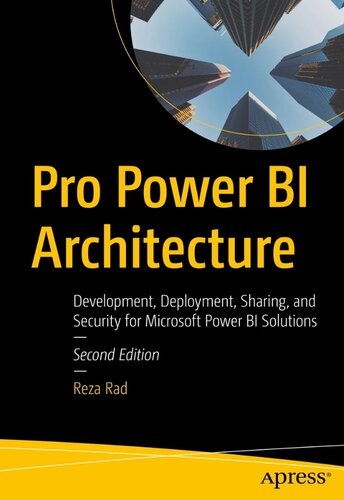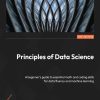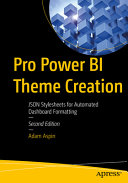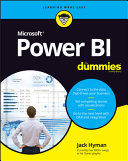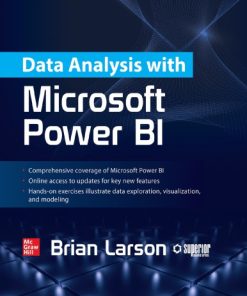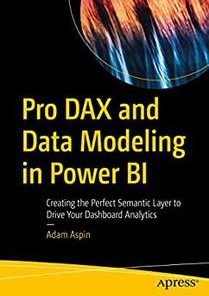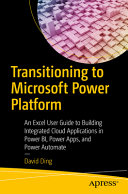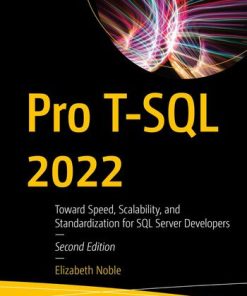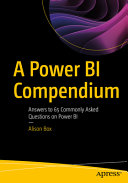Pro Power BI Architecture 2nd Edition Reza Rad
$50.00 Original price was: $50.00.$25.00Current price is: $25.00.
Pro Power BI Architecture 2nd Edition Reza Rad – Ebook Instant Download/Delivery ISBN(s): 9781484295373,1484295374, 9781484295380, 1484295382

Product details:
- ISBN 10: 1484295382
- ISBN 13: 9781484295380
- Author: Reza Rad
This book provides detailed guidance around architecting and deploying Power BI reporting solutions, including help and best practices for sharing and security. You’ll find chapters on dataflows, shared datasets, composite model and DirectQuery connections to Power BI datasets, deployment pipelines, XMLA endpoints, and many other important features related to the overall Power BI architecture that are new since the first edition. You will gain an understanding of what functionality each of the Power BI components provide (such as Dataflow, Shared Dataset, Datamart, thin reports, and paginated reports), so that you can make an informed decision about what components to use in your solution. You will get to know the pros and cons of each component, and how they all work together within the larger Power BI architecture. Commonly encountered problems you will learn to handle include content unexpectedly changing while users are in the process of creating reports and building analyses, methods of sharing analyses that don’t cover all the requirements of your business or organization, and inconsistent security models. Detailed examples help you to understand and choose from among the different methods available for sharing and securing Power BI content so that only intended recipients can see it. The knowledge provided in this book will allow you to choose an architecture and deployment model that suits the needs of your organization. It will also help ensure that you do not spend your time maintaining your solution, but on using it for its intended purpose: gaining business value from mining and analyzing your organization’s data. What You Will Learn Architect Power BI solutions that are reliable and easy to maintain Create development templates and structures in support of reusability Set up and configure the Power BI gateway as a bridge between on-premises data sourcesand the Power BI cloud service Select a suitable connection type—Live Connection, DirectQuery, Scheduled Refresh, or Composite Model—for your use case Choose the right sharing method for how you are using Power BI in your organization Create and manage environments for development, testing, and production Secure your data using row-level and object-level security Save money by choosing the right licensing plan Who This Book Is For Data analysts and developers who are building reporting solutions around Power BI, as well as architects and managers who are responsible for the big picture of how Power BI meshes with an organization’s other systems, including database and data warehouse systems.
Table contents:
Part I. Getting Started
1. Power BI Components
2. Tools and Preparation
Part II. Development
3. Import Data or Scheduled Refresh
4. DirectQuery
5. Live Connection
6. Composite Model
7. DirectQuery for Power BI Datasets and Analysis Services
8. Choosing the Right Connection Type: DirectQuery, Live, Import, or Composite Model
9. Dataflows
10. Shared Datasets
11. Datamarts
12. The Multi-Layer Architecture
13. Datamarts vs. Dataflows vs. Datasets
14. Paginated Reports
15. Excel and Power BI Integration
16. Real-Time Streaming Datasets in Power BI
17. Performance Tuning with Aggregations
18. Big Data with Incremental Refresh and Hybrid Tables
19. Development Best Practices
Part III. Deployment and Collaboration
20. The Power BI Service
21. The Power BI Report Server
22. Power BI Gateways
23. Power BI Licensing
24. Power BI Admin Portal and Tenant Settings
25. PowerShell Cmdlets for Power BI
26. Power BI REST API
27. Power BI Audit Log for the Tenant
28. XMLA Endpoint
29. Dashboard and Report Sharing
30. Power BI Workspaces
31. Power BI Apps
32. Publish to Web
33. Power BI Embedded
34. Secure Embed
35. Embed in SharePoint Online and Teams
36. Comparison of Sharing Methods for Power BI
37. Types of Power BI Users
38. Best Practices for Setting Up Workspace Roles
39. Build Access Level
40. How to Organize Workspaces in a Power BI Environment
41. Content Certification and Endorsement
42. Deployment Pipelines
43. Data-Level Security
44. Power BI Helper
People also search:
power bi pro requirements
power bi architecture best practices
power bi server architecture diagram
microsoft power bi architecture diagram
azure power bi architecture
You may also like…
Computers - Organization and Data Processing
Computers - Applications & Software
Computers - Organization and Data Processing
Computers - Programming
Uncategorized
Computers - Enterprise Computing Systems
Computers - Databases
Computers - Algorithms and Data Structures
A Power BI Compendium: Answers to 65 Commonly Asked Questions on Power BI First Edition Alison Box


